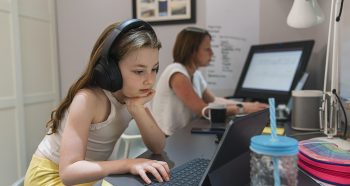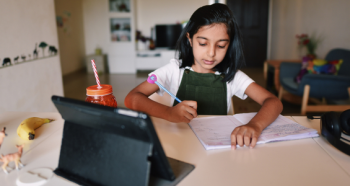Every morning, at 10.00 am, I am greeted by the smiling faces of my two grandchildren, aged 2 and 7. My wife and I are really missing seeing them in person, but this daily video call helps make up for the lack of physical contact. We spend 20 minutes exploring number structures using his Cuisinaire rods, and then another 20 minutes working on something from the internet (specific examples below). When the parents of my grandson’s friends found out, they asked me to set up a WhatsApp group, called #makingmathsfun(hopefully). Every morning at 9am, I set up some activities and the mums and their children report on their progress during the day. Both parents and children report that they are having fun!
For example, I have suggested that the children explore the house for examples of 2D and 3D shapes. I want to try and encourage children (and their parents and carers) to see mathematics in the everyday. Once we start to notice shapes around us, we can’t stop noticing them. I also want mathematics to be a collaboration between parent and child, not something that is passed on from me to the child via the parent, who simply acts as a conduit. I hope that this will change the relationship that the children have with mathematics and – perhaps more importantly – the relationship the parents have with learning and teaching mathematics.
A ‘virtual holiday’
In the first week of the spring break, I suggested that the children select a place that they want to visit and plan a ‘virtual holiday’. This involved finding out how to travel to the place, researching how long it would take to get there, and using timetables to choose a journey. Then we set out a budget for the journey, for accommodation, and for spending money. We used the website numbeo.com/costofliving to find out comparative prices and did some simple currency conversions. My grandson’s chosen destination was Jamaica!
How big are things?
Another extended project over a week involved the children putting together books called, ‘How big are things?’. They spent one day measuring objects at home, another day weighing them, and the final day finding capacities of containers. By doing this, they have come to develop a good sense of measurements. Knowing what 500 ml ‘looks like’ or what 500 grams ‘feels like’ is a very useful life skill!
Use children’s interests and everyday activities
Wherever possible I try to draw on the children’s interests. For example, my grandson loves creating environments with his toy car track. We have designed lots of experiments using this. He can now tell you which cars are quickest down the track and which can ‘jump’ the furthest, and he has a list of ‘world records’. Similarly, when the International Space Station was visible from our back gardens, we spent time thinking about how far away the planets are from the earth. There is a fantastic activity on the NRICH website that builds on these ideas.
I am also encouraging parents to share the everyday activities which are in themselves mathematical: every time we cook, shop online, work out if we have time to do something, we are being mathematical. Parents are now getting into the habit of asking their children what time it is, asking them to measure the ingredients for cooking, or work out the total bill for the shopping.
Planting these habits of mathematical thinking in young minds now means they are more likely to grow and flourish in the future.
Get in touch
One of my roles is editing Mathematics Teaching, the journal of the Association of Teachers of Mathematics. I would be interested in knowing how you are responding to the current crisis and how you are developing mathematical thinkers out of school. Do contact me at (journaleditor@atm.org.uk ) It would be fantastic to share some of your responses.
Useful resources
Resources that I have found particularly useful are available at:
https://nrich.maths.org/ – Activities aimed at learners of all ages with clear teacher’s notes and the facility to upload ‘solutions’, which is a great motivator for many learners.
https://www.atm.org.uk/Maths-Teaching-Resources – The website of the Association of Teachers of Mathematics. Many of these resources are currently available to non-members to support them at the current time.
https://www.stem.org.uk/home-teaching – The STEM centre in York has developed resources for home learning in Science, Technology, Engineering and Mathematics.
https://www.numberphile.com/ – An amazing collection of videos and podcasts covering every facet of mathematics.
https://www.gresham.ac.uk/watch/?subject=mathematics – A series of lectures around several fascinating mathematical topics. Most suitable for GCSE and A Level students.





